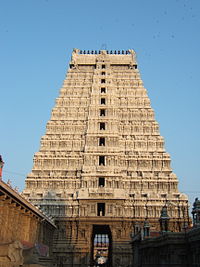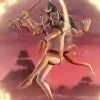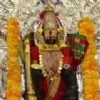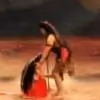Annamalaiyar Temple
Annamalaiyar Temple is a Hindu temple dedicated to the Hindu deity Shiva, located at the foothills of the Annamalai Hill in the town of Thiruvannamalai in Tamil Nadu, India. Shiva is worshipped as Annamalaiyar or Arunachaleswarar represented by lingam, with his consort, Parvati in the form of Unnamulaiyamman. The temple occupies a significant place in Saivism and is regarded as one of the five temples associated with the five classic elements of nature, called the Pancha Bhoota Stalas. The temple is associated with the natural element fire, called Agni and the presiding deity, Arunachaleswarar in the form of lingam is called Agni lingam.[1][2] The temple is revered by the Tamil Saiva canonical work of the 7th century, the Tevaram, by Tamil saint poets called the nayanars and is classified as a Paadal Petra Sthalam – the temples reverred in Tevaram. It is believed that the 9th century Saiva saint poet Manikkavasagar composed the Tiruvempaavai in the temple.
The temple complex covers an area of 10 hectares and is one of the largest temples in India.[3] It houses 4 gateway towers, the gopurams, with the tallest being the eastern tower with 11 storeys and a height of 66 metres (217 ft), making it one of the tallest temple towers in India.[3]
The Karthigai Deepam festival is celebrated during the full moon day in November–December and a huge beacon is lit on the top of the hill. It can be seen from miles around and believed to be Shiva's lingam of fire joining the limitless skies.[4] The event is witnessed by 3 million pilgrims. During each full moon day, a worship called Girivalam is followed when pilgrims circumnavigate the base of the temple and the Annamalai hill.[3][4] The Girivalam is carried out by around 1 million pilgrims.
Legend
The present masonry structure and towers date back to the 9th century CE. This has been determined from an inscription in the structure made during the reign of Chola kings who ruled the region during the era.[9] Inscriptions indicate that Tiruvannamalai was under the Pallava Kings who ruled from Kanchipuram before the 9th century.[10] The 7th century Nayanar saints Sambandar and Appar, have mentioned the deity in their poetic work, Tevaram.[11] Sekkizhar, the author of the Periyapuranam mentions that both Appar and Sambandar worshipped Annamalaiyar in the temple.[11] The Chola Kings ruled over the region for more than four centuries from 850 CE to 1280 CE and have made donations to the temple.[12] The Hoysala kings had Tiruvannamalai as their capital from 1328 CE.[13] There are 48 inscriptions from the Sangama Dynasty (1336–1485 CE), 2 inscriptions from Saluva Dynasty and 55 inscriptions from Tuluva Dynasty (1491–1570 CE) that ruled the Vijayanagara Empire, indicating generous gifts to the temple from the rulers.[14] There are also inscriptions from the rule of Krishnadeva Raya (1509–1529 CE), the most powerful Vijayanagara king, indicating generous contributions to the temple.[10] Most of the Vijayanagara inscriptions were written in Tamil and a few in Kannada and Sanskrit.[15] During 17th century CE, the temple came under the sway of the Nawab of the Carnatic. There was confusion and chaos after 1753.[5] Muraru Raya, Krishna Raya, Mrithis Ali Khan, Burkat Ullakhan, French Soupries and Sambrinet, English Captain Stephen Smith besieged Tiruvannamalai and had their successes and defeats. The French occupied the town in 1757 and it came under the control of British in 1760.[12] In 1790 CE, the area was captured by Tippu Sultan (1750–99 CE).[5] During the first half of the 19th century, it came under the British rule.[12] The temple in modern times is maintained by the Hindu religious and Endowment board (HR & CE) of the Government of Tamil Nadu.[11] During 2002, the Archaelogical Survey of India (ASI) took brief control of the temple to declare it as a national heritage monument; widespread protests and cases filed against the move in the Supreme Court of India lead ASI to cede the control back to the HR & CE
Architecture
In addition to the spiritual importance, Tiruvannamalai as a town was situated at a strategic cross road during the Vijayanagara empire.[17] The town connected sacred centres on the pilgrimage route that included the temple and also linked military outposts.[17] There are inscriptions showing the city being classified as an urban centre before the precolonial period and that the city grew around the temple like in most Nayak ruled cities like Madurai.[17]
Complex and towers
The temple is situated at the bottom of the Annamalai hill facing East.[11] The temple occupies an area of about 25 acres of land.[11] The walls on the east and west measure 700 ft (210 m) each while that of the south measures 1,479 ft (451 m) and the northern one measures 1,590 ft (480 m).[11] It has four gateway towers, the gopuram, on all the four sides. The eastern tower, called the Rajagopuram, is the tallest of all the towers of the temple.[11] The base of the Rajagopuram is made of granite measuring 135 ft (41 m) by 98 ft (30 m).[11] This tower was built by king Krishnadevaraya (1509–29 CE) of Vijayanagara dynasty and completed by Sevappa Nayaka (1532–80 CE).[18][12] The inscriptions indicate that the tower was built on the request of Sivanesa and his brother Lokanatha in 1572 CE.[19] The southern tower is called Thirumanjangopuram and the western tower is called Pei Gopuram. Ammani Ammal, a Sanyasini built the northern tower which is named after her. The literary works of Nayaks, Raghunathabhyudayam and Sangitha Sudha have mention about the towers.[19] The Tanjavuri Andhra Raja Charitamu mentions Krishnadevaraya building the tower and the outer precincts of the temple.[19] The temple has five precincts.[20] Each of the precinct has a huge Nandi (sacred bull of Shiva) and several towers such as the Vallala Maharaja Gopuram and Kili Gopuram, meaning the Parrot Tower. As per the temple legend, saint Arunagirinathar attained divinity by taking the form of a parrot, after which the shrine is named.[21] An image of the story can be found in the tower.[21]
Shrines

The Raja gopuram – the Eastern gateway and the tallest temple tower
The east facing main shrine of Annamalaiyar houses images of Nandi, the sacred bull and Surya, the Sun god.[20] It is the oldest of all structures in the temple.[20] Right behind the walls of the sanctum, there is an image of Venugopalaswamy, an incarnation of Hindu god Vishnu. Around the sanctum, there are images of Somaskandar, Lingodbhavar (image of Shiva emnating from lingam), Durga, Chandekeswarar, Gajalakshmi, Arumugaswami, Dakshinamoorthy, Swarnabairavar and Nataraja, The Palliyarai, the divine room meant for resting deities is located in the first precinct around the sanctum. The shrine of the consort, Unnamalai Amman lies in the second precinct of the temple – the Amman is depicted in a standing posture. Sambantha Vinayagar (elephant god) shrine is located to the north of the flag staff and the Bali peeta (platform for sacrifice).[22] To the south of the thousand-pillared hall, there is a small shrine for Subramaya and a large tank.[4] "Pathala Lingam" (underground lingam) is the place where Ramana Maharshi (1879 – 1950 CE) is believed to have performed his penance.[21][23] The shrine of Sivagangai Vinayagar is present in the northern bank of the Sivanganga tank.[22]
Halls
There is a 16 pillared Deepa Darshana Mandapam (meaning the hall of light) in the third precinct. The temple tree, Magizha, is considered sacred and medicanal; childless couple tie small cradles in the branches as a form of worship. Vedic texts describe the mast of the temple separated the earth and the sky during the creation of the universe.
[24] The Kalyana Mandapam, the marriage hall, is in the south-west of the precinct and is built in Vijayanagara style. A stone trident is present in the outer shrine of the temple in open air and has protective railings like a sacred tree.
[25] The Vasantha Mandapam, meaning the Hall of spring, the temple office and Kalahateeswarar shrine are located in the third precinct.
[26] The fourth precinct has an image of a large Nandi, Brahma Theertham (the temple tank), Yanai Thirai Konda Vinayaga shrine and a hall with a big Nandi 6 ft tall erected by Vallala Maharaja.
[22] Inside the doorway of the first tower and the fifth precinct, there is a thousand-pillared hall built during the late Vijayanagara period.
[4] Krishnadevaraya constructed the hall and dug the tank opposite to it.
[4][27] The pillars in the hall are carved with images of
yali, a mythological beast with body of lion and head of an elephant, commonly used as the symbol of Nayak power.
[28] The Arunagirinathar Mandapam is located to the right of the Kalayana Linga Sundara Eswara Mandapam and Gopurathilayanar shrine to the left of the broad flight of stone stairs that lead upwards to the Vallala Gopuram.
Festivals
The temple celebrates dozens of festivals throughout the year.[29] Four prime festivals, called the Brahmotsavam are celebrated every year, the important of which is celebrated during the Tamil month of Karthikai (November/December). The celebration of Karthikai Deepam marks the conclusion of the ten-day festival. A huge lamp is lit in a cauldron with three tons of ghee at the top of the Annamalai hill during the Deepam.[4][30] To mark the occasion, the festival deity of Annamalaiyar circumbulates the mountain. Inscriptions indicate that the festival was celebrated during the Chola period itself, while it was expanded to 10 days in the 20th century.[20]

Temple car during a festival
Every full moon night, tens of thousands of pilgrims worship Annamalaiyar by circumambulating the Arunachala hill barefoot.[4] The circumambulation covers a distance of about 14 kilometres (8.7 mi) and is referred as Girivalam.[31] As per Hindu legend, the circumbulation removes sins, fulfillment of desires and freedom from cycle of birth and rebirth.[11] Offerings are made in a string of tanks, shrines, pillared meditation halls, springs and caves around the hill.[2] The practise is followed during normal days also and is referred as Giri Valam. On the day of yearly Chitra Pournami, the full moon night in the Tamil calendar, lakhs of pilgrims come from across the world to worship Annamalaiyar.[11] Five temple cars, called ther, with wooden carvings, are used for the procession.[11]
Tiruvoodal is another festival celebrated during the first week of Tamil month
Thai (from 14 till 18 January) every year.
[32] On the morning of
Maatu Pongal (15 and 16 January), Nandi, the sacred bull of Shiva, is decorated with garlands specially made with a variety of fruits, vegetables and sweets. Annamalaiyar and his consort come out of the temple to perform the
oodal ceremony in the evening. The event happens outside the temple on the Tiruoodal street
Saints and literary mention
Tirugnana Sambandar, a 7th century Tamil Saivite poet refers Annamalai and his consort Unnamalai in 10 verses in Tevaram compiled as the First Tirumurai.[36] Appar, a contemporary of Sambandar, refers Annamalai in 10 verses in Tevaram, compiled as the Fifth Tirumurai.[37] A poem from the First Tirumurai by Sambandar is as under –
Tamil
????????? ???????????? ??????? ???????
????????? ??????????? ????????? ????
??????????? ???????????? ????????? ???????
???????? ???????????? ????????? ?????.[38] | IAST
u'n'naamulai yumaiyaa'lodum udanaakiya voruvan
pe'n'naakiya perumaanmalai thirumaama'ni thikazha
ma'n'naarnthana varuviththira'n mazhalaimmuzha vathirum
a'n'naamalai thozhuvaarvinai vazhuvaava'n'na ma'rumae.[39] |
"the unequalled god who is united with U??amulai Umai, having fixed her in the left half of this body. the mountain which belongs to the Lord who is completely a lady. the big gems of sapphire to shine the acts, good and bad, of those who worship with joined hands A??amalai, where the collection of streams which are full of fertile silt and which make a gentle sound, will be severed from them without fail."[39] |
Manickavasagar, a 9th century Tamil saint poet has revered Annamalaiyar with his verses and refers to the deity as "AnnAmalai".
[40] He composed the
Thiruvempavai in the Tamil month of Margazhi in the temple.
[41] Arunagirinathar is a 15th century Tamil poet, who was born in Tiruvannamalai and spent his early years as a rioter and seducer of women; after having ruined his health he tried to commit suicide by throwing himself from the northern tower, but was believed to have been saved by the grace of god Murugan.
[42] He became a staunch devotee and started composing Tamil hymns glorifying Murugan – the notable being the
Thirupugazh.
[12][43] The western world learnt about Tiruvannamalai during the mid of 20th century after the advent of the popular saint, Ramana Maharishi (1879–1950 CE).
[44][1] Ramanar's meditation cave is located on the lower slopes of the Annamalai hill and the
ashram (hermitage) complex is on the foothills.
[45][23] The basement of the raised hall inside the temple has
Partha Lingam, where Ramanar is said to have attained supreme awareness while ants devoured his flesh.
[45] The place is also called a
Mukthi Sthalam, meaning a place of salvation, and a lot of saints like Seshadri Swamigal, Gugai Namachivayar and Yogi Ramsuratkumar are associated with the temple
(Sorry if it is already shared)






































